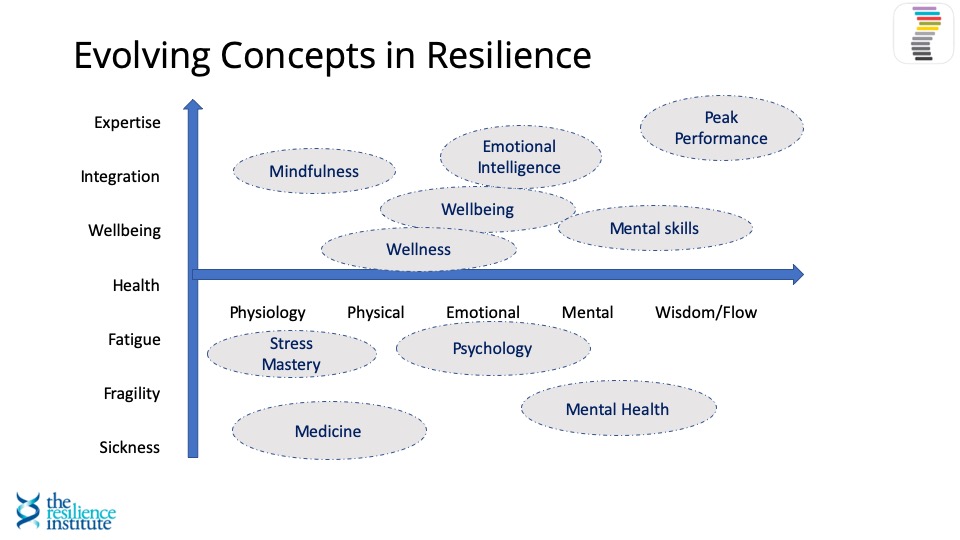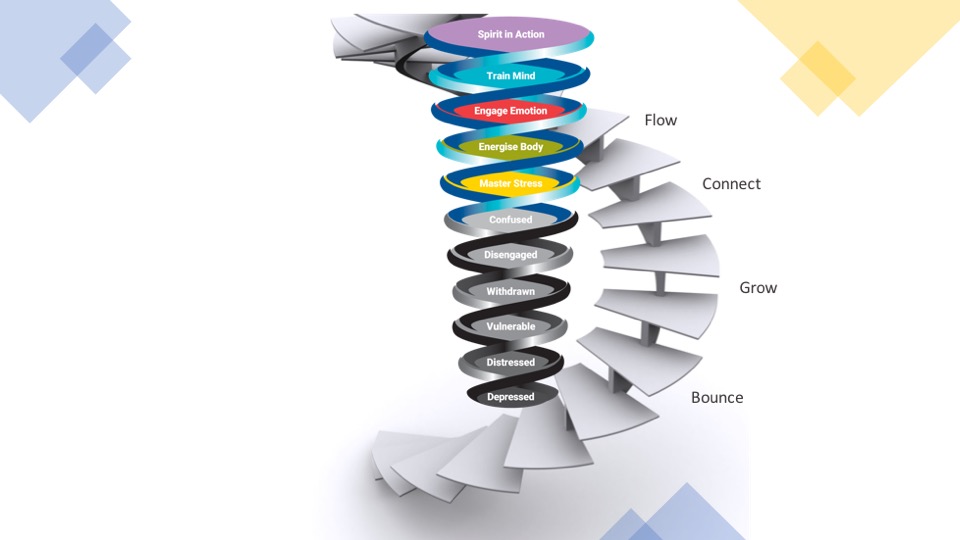
Our History of Resilience
With a professor-of-paediatrics-dad, a psychiatric-social-worker-mum, two competitive brothers, special forces, triathlon, ocean swims, surfski racing, medicine and an MBA, resilience promised to be an easy gig.
While engaging and fulfilling, it’s been a long, complex and difficult road. We have helped tens of thousands of people and many businesses. Evolution has been slow. It has been maddeningly difficult to scale what should be a very good business.
In the early days, my family and medical colleagues thought I had lost it. Executives considered me very strange. Why on earth would you try to build resilience when it was genetic? Surely, it is not our role to fiddle in the personal affairs of our employee’s health, suffering, emotions and thoughts? Why prevent disease when you can get very rich treating it?
Today, “resilience” along with a bewildering list of synonyms is a core topic in parenting, education, business, NGOs, governments, infrastructure, ecosystems and sport. Billions are being invested in new ventures. It is a celebrity feeding frenzy dosed with gurus, placebos, and scams amidst true experts.
This reflection on history from my perspective explores the big challenges, important foundations for success, the science and evidence, mistakes, and how the future might look.
Discovering Resilience
“Resilience” first popped into my consciousness in 1994 thanks to Daryl Conner (Managing at the Speed of Change).
He introduced the role of resilience in leading change. The idea was not new. My parents were pioneers using medicine to shape better lives. Sport taught me the disciplines of expertise. Special forces demonstrated the incredible depth of human will. Sports medicine framed it in modern science. My spin on the idea was simple:
“Can we use business and organisations to develop the capacities of excellence in more communities?”
At the time health insurers had studied the impact of simple physical wellbeing programs. Foundations were being established. A good program included leadership engagement, health risk assessment and relevant lifestyle education. The early studies showed:
- Health risk factors could be reduced
- Sickness events and costs reduced
- Absenteeism reduced
- Staff turnover reduced
- Morale and productivity improved
In a nutshell, health status improved, sickness care costs reduced, and the organisation was getting a positive ROI. Studies showed that an organisation could expect a net present value of $2 to $3 for every $1 invested. This was the US market with double the health costs of most developed economies. In a public funded health system, the incentives for organisations to manage health risk are limited.
In 1989, we were developing simple health risk assessments and basic workshops in health risk management, exercise and nutrition. In 1992, I built my first healthcheck to be completed electronically. Early adopters were definitely interested but mostly these were senior executives and professionals.
When a client asked me to include “stress management” with an executive health program. I discovered Merv Dickinson (with a PhD in leadership psychology). We designed interventions to grow self-awareness and self-mastery skills and kicked off a partnership in executive leadership development.
This was a transformative time for me. Merv mentored me into the world of emotions, mind and spirit and how to facilitate leadership teams. Our first resilience programs were up and running. Enlightened business was interested.
After an MBA and five years of an executive health clinic, I was finally ready to launch the Resilience Institute. The intention was clear. Engage leaders, run quality health assessments and provide evidence-based and motivational workshops to encourage behaviour change. And we got it. We could show that various physical, emotional and mental measures and experiences changed positively. There was a positive buzz in our engagements.
At the time and through most of 2000 to 2010 there was little competition. We had a free run. The market was tiny. The concept was peripheral at best. It proved tough to create a viable business. However, it was a productive period. We completed healthchecks on thousands of people, ran hundreds of workshops, pioneered the concept into Australia. Data became important and we learned to collect and present health and resilience data while respecting privacy and security.
Emotional Intelligence, Neurobiology and the Resilience concept matured. I trained with Daniel Goleman and then Andrew Shatte, learning how to assess and coach the emotional and cognitive aspects. We formed small teams with our colleagues in Australia, Europe, Singapore and the UK.
We slowly increased our reputation and impact in a number of global organisations. Clients like PwC, GE, AXA, and various Banks teamed with us and pushed our development.
Then in 2014, I realised we had to digitise further. Training was going to digitise, and the world of Apps was expanding. We had to expand from simple online digital assessments. The next period was really interesting. We ran a series of psychometrics and analytics on our assessments, experimented with new platforms, recorded all our workshops into short micro-training videos, considered how to build tracking and artificial intelligence into the platform. Our Resilience App was born.
At the same time, the rest of the world sprang to life. Resilience became mainstream. Organisations sought it out. Entrepreneurs, scientists and celebrities rushed to start businesses to make money while doing good. The variability is enormous from overnight charlatans to super-credible, deep specialists providing expert solutions.
As I write, hundreds of start-ups are investing billions in establishing solutions. There are already 10,000 apps in the market offering various self-improvement options. Many established businesses such as consulting firms have become ‘experts’. Your accountant may have become your psychiatrist. Consultants have resilience on their calling card for good measure. It is a chaotic time. As a provider, organisational buyer or individual consumer it is messy.
Defining resilience
Resilience today is where Logistics was in World War 2. The challenge is to integrate a vast number of interacting and moving parts. Each part has specialists protecting their domains and striving to dominate the solution. Will it be the sports scientists, psychologists, neurobiologists, doctors, coaches, tech giants, or the big four?
Our first challenge is to define, clarify and simplify language. Wellness means many different things and depression can be addressed with multiple approaches. What are we buying? Wellness, mental health, wellbeing, well-being, emotional intelligence, mental skills, stress mastery, peak performance or medical services.

Two axes are required to make sense of both the need and the required solution. The vertical axis attends to level of function from a diagnosis of disease to an example of excellence. The horizontal axis helps define the territory. Quickly examining your understanding and testing where you might move the solutions will uncover confusion.
Providers, purchasers and research would benefit from clarity.
Our second challenge is to integrate the concepts in a realistic, evidence-based and practical framework. This requires respect for each of the fields involved. While defending the boundaries we have to be flexible and generous. A psychologist might wish that CBT is the only solution to depression. With wisdom and flexibility, they might acknowledge that sleep, fitness, connections, breath training or medication may work better for some clients.
Our Diagnostic and Development model seeks to define the level of function and the options available to focus attention. Even experts suffer from mental illness and those who are sick can benefit from non-medical interventions. Some of us view the world through a more physical lens while others prefer emotions, mind or spirit.

There are many paths to resilience. To be a good coach, trainer or consultant is to recognise the perspective of the client and adjust the options you present in a language they can connect with. A good framework and basic training in the different disciplines will help us move more people in a positive direction.
Measuring Resilience
While any assessment might be helpful to increase self-awareness, we can do better. For the reasons above, a good assessment must be evidence-based, integral and practical. Most are based on one framework (say, CBT), one level of function (depression), and only one level of resilience (mental or emotional). Many psychological assessments are built on theories and tests with paid students. They don’t always translate to other communities.
The right assessment has to be clear, simple, the right length, reliable and valid. This takes years of psychometrics with different populations, experiments with reporting, and evaluating the impact of interventions. The web and apps have transformed our ability to run such assessments, but people will only complete them if they are compelling.
Wearable technology allows us to add objective measures such as steps, heart rate, sleep, heart rate variability, and even blood pressure. Combined with subjective answers, we are moving toward much more powerful assessment tools. We may well get to the point of having a panel of measures that could align:
- Physical: heart rate, blood pressure, heart rate variability.
- Emotional: heart rate variability, positive: negative emotions ratio.
- Mental: focus time, switching, idea generation, situational agility.
Evidence for Resilience
Decisions on investment are driven from three perspectives. One is the organisation (and leaders) who believe it is the right thing to do. They value their people, want to reduce suffering, ideally increase wellbeing and performance, and be a good employer. They trust that it works and want a credible provider. Their people engage whole-heartedly.
The second is based on economics. This organisation (and leaders) ask what return the organisation will get from the investment. They want to know what costs will reduce and what benefits will accrue in dollars. If they cannot see a financial return, the state of their people is not their concern. They are not in the market. Their employees need help.
The third is based on fear. This is why safety and mental health are such lucrative services. The organisation (and leaders) are terrified of risk and being punished. They want to know what risks they face and must be seen to be mitigating these risks with an expensive report. They tend to gravitate to the bottom of the spiral and may end up spending significant resources mitigating risk that exists in a very small number of people. The rest run for the exit.
Ideally, a good resilience solution addresses all three needs. Organisations must understand and mitigate risk, improve the function and productivity of people, and seek to be a good employer. It is our duty as professionals to demonstrate the effectiveness of an investment in resilience and the potential ROI. It is difficult, expensive and time-consuming. Solutions have to bring an evidence-based, integral framework, measure with an effective assessment, provide a comprehensive dashboard, offer both face-to-face and digital engagement options, set meaningful goals and follow up with reassessments.
There is good evidence that resilience initiatives deliver results. Many still focus on single factor gains such as health improvement, positivity or optimism. We have been able to show that resilience as a whole improves, each of the 11 categories improve and every one of the 60 factors improves in the post training assessment.
Even better, a good assessment can indicate where your risks and strengths are so that the company can target the right training to the right people. In my view, this is the challenge facing the enlightened organisation.
The Future of Resilience
We have eliminated many of the risks and fitness tests of survival. Natural forces are temporarily at bay. Much of the suffering – physical, emotional and mental – is linked to self-neglect. The pressures of modern life trigger slow burn distress for which we are completely unprepared.
The costs measured in lifestyle diseases, loneliness, distress, anxiety, and depression are enormous and increasing fast. With nature at bay, communities, families and individuals are going to have to step up to owning resilience. When we neglect our body, emotions and mind, there is a personal and community cost. When we build these resources there are massive benefits. Especially, when nature provides a shock – fires, floods, earthquakes.
We understand this. The evidence is clear. The unsustainability of inaction is obvious. Enlightened communities and organisations are on the job. Over the next decade we will see an enormous increase in human resilience investments. The upside of helping people build resilience and risk of not doing so, will be clear. The reality will confront governments, health systems, education, business, communities, families and individuals.
Assessments will combine with data analytics and artificial intelligence, providing powerful insights into where risks and opportunities lie and how to engage them with precision. The implementation, training and coaching will move from consultants to in-house resources. Just like a sports team has an extensive support, logistics and specialised coaching resources, so a business will bring these resources in-house.
Some people are already on board. They take full responsibility for tracking and growing their resilience. They search for experts, put in place the daily disciplines, and experiment with devices. They are thriving from the benefits. Just watch Frankie and Grace.
Many are on the threshold. With the right communications and engagement, they too can rapidly take advantage of resilience.
Some are resistant or simply so overwhelmed by other concerns that self-neglect is a way of life. Here we will need kindness with wisdom and courage. They may need a firmer hand and more intensive support to help them bounce, grow, connect and find flow. This is a gritty challenge.
